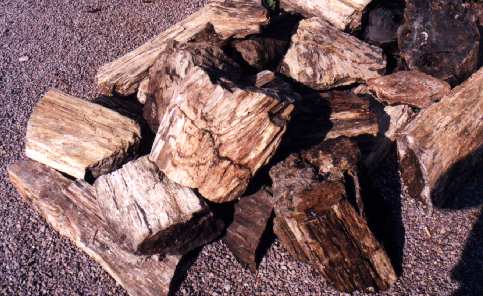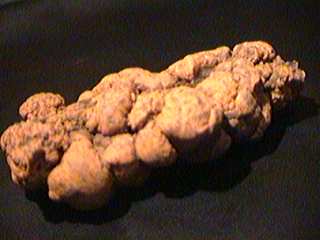What's a fossil?

These tree sections
are made of stone. A volcanic eruption covered the trees with
ash 3 million years ago turning them into fossils.
(Copyright Lee Krystek 2000)
A fossil is the prehistoric remains of a plant
or animal. Fossils are typically preserved when they are buried
under many layers of sand and mud. Under great pressure the
sand and mud become sedimentary rock. Minerals seep into the
fossil replacing the organic matter and creating a replica in
stone.

 A fossil can be a trace
fossil or a body fossil. A body fossil is what was actual organic
material from a creature or plant (like a bone). Trace fossils
are signs of plant and animal activity that have been preserved
in rock. For example, dinosaur tracks, trails and dung are all
trace fossils.
A fossil can be a trace
fossil or a body fossil. A body fossil is what was actual organic
material from a creature or plant (like a bone). Trace fossils
are signs of plant and animal activity that have been preserved
in rock. For example, dinosaur tracks, trails and dung are all
trace fossils.
A body fossil is usually composed of the bones
of an animal. Preservation of the "soft" tissue of a body is
rare especially over long periods of time. Most body fossils
are made when an animal dies and falls, or is washed into a
stream, and is covered with mud.
In a few cases, though, fossils have been preserved
by freezing ( as with mammoths in
Siberia and Alaska) or when the animals have become mired in
a tar pit (such as the famous La Brea tar pit near Los Angeles,
California).
Sometime a fossil is the result of a volcanic
eruption. Ash and mud from the volcano can cover animals and
plants killing and preserving them at the same time.
Fossils come in all sizes. The largest are dinosaur
bones (which may be ten or more feet in length for a single
bone) and the smallest are plant spores only a few hundredths
of an inch across. The study of fossils is called Paleontology.
The study of fossil plants is Paleobotany.
Fossils exist all over the world. As hills erode,
fossils become visible and a Paleontologist can find and remove
them for study. Sometimes a small area only a few hundred feet
across will be jammed with skeletal remains. This is called
a "bone bed." A bone bed maybe the site of a sandbar on an ancient
river. During floods, the bodies of many animals floated downsteam,
grounded on the bar, and quickly got covered with silt and were
preserved.
Removal of fossils from the rock is done very
carefully to avoid damage to the specimen. Photographs are taken
to record the position of the bones as they were found. These
aid scientists as they attempt to reconstruct fossil skeletons.
Fossils are laid down in the rock layers in order
of age. The oldest fossils are deeper and the new fossils farther
up in another "strata" of rock. Geologic action, though, jumbles
this over a wide area so that fossils from the Cretaceous Era
(65 million years ago) might be on the surface only a few miles
from fossils of the Ice Age (10,000 years ago). A Paleontologist
knows where to go to find the right age rock for the type of
fossils he is seeking.
The petrified lump
of dinosaur dung is a "trace" fossil. (Copyright
Lee Krystek 1996)

 Next
Stop on Dinosaur Safari
Next
Stop on Dinosaur Safari

Copyright Lee Krystek 1996.
All Rights Reserved.